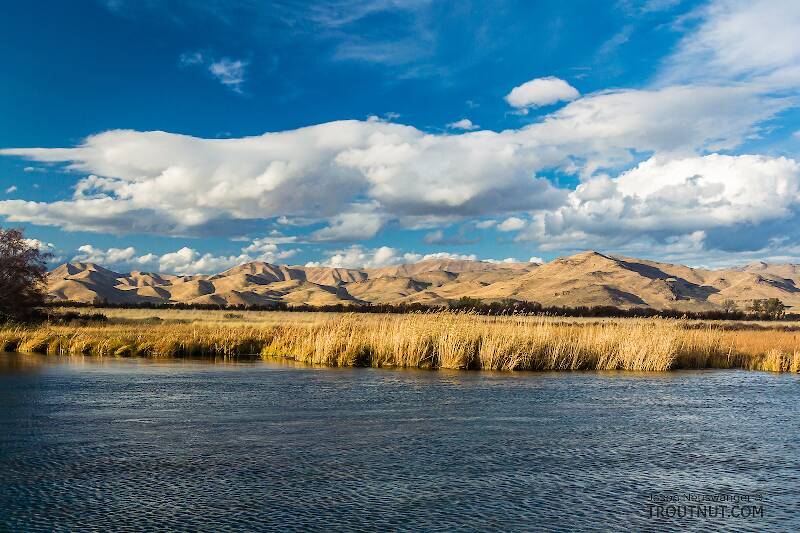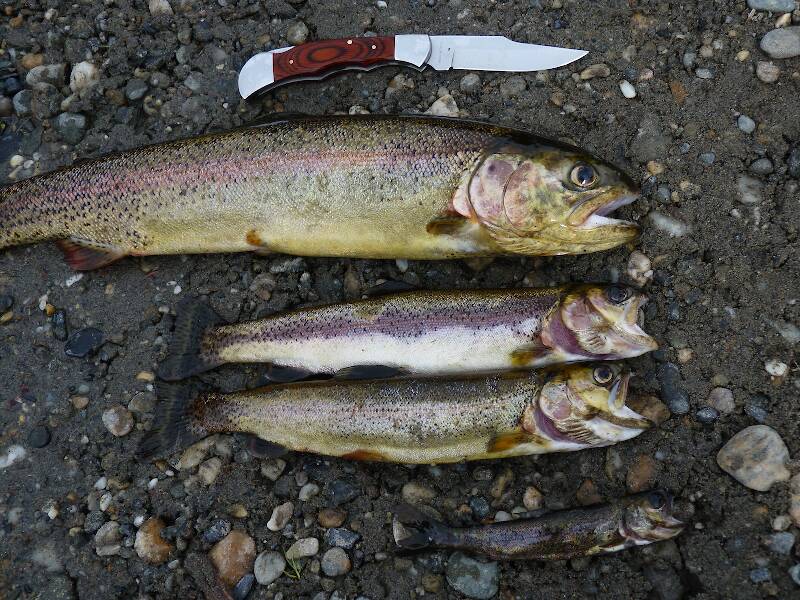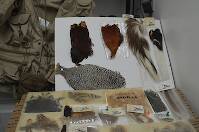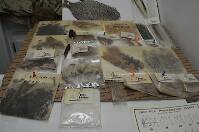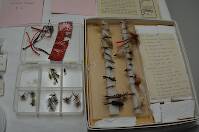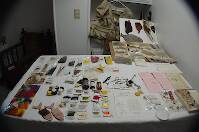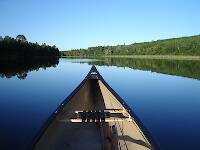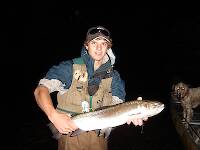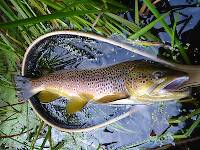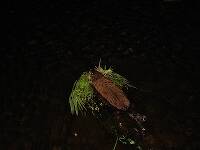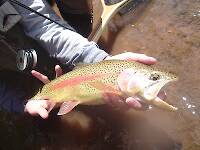
Salmonflies
Pteronarcys californica
The giant Salmonflies of the Western mountains are legendary for their proclivity to elicit consistent dry-fly action and ferocious strikes.
Featured on the forum

I was not fishing, but happened to be at an unrelated social event on a hill above this tiny creek (which I never even saw) when this stonefly flew by me. I assume it came from there. Some key characteristics are tricky to follow, but process of elimination ultimately led me to Sweltsa borealis. It is reassuringly similar to this specimen posted by Bob Newell years ago. It is also so strikingly similar to this nymph from the same river system that I'm comfortable identifying that nymph from this adult. I was especially pleased with the closeup photo of four mites parasitizing this one.

Troutnut is a project started in 2003 by salmonid ecologist Jason "Troutnut" Neuswanger to help anglers and
fly tyers unabashedly embrace the entomological side of the sport. Learn more about Troutnut or
support the project for an enhanced experience here.
PaulRoberts on Feb 19, 2012February 19th, 2012, 5:09 pm EST
I want to share a neat material I’ve been using for some time now, and am still experimenting with. It’s laboratory Parafilm (Fisher Scientific), a stretchy, thermoplastic film that makes nice translucent insect bodies.
I get a kick out of using found materials to make flies from. I guess I enjoy the DIY creative side of fly tying a lot. Many of you may not like this stuff since there are already other ready-made materials that do similar things (although not the same) such as larva lace and other clear stretchy materials. For those who like to dabble in such things, I’ll offer the following.
The “thermoplastic” property of PF means that it will fuse together with the heat from your hands, making it durable as a fly body in terms of it’s staying on the hook, and not unwraveling. It can be torn by fish teeth, and you cannot grasp it with hemostats or you will crush it. But it’s durable enough to catch many fish on and is easy to tie with once you know how to prepare it.
I use it by rolling and stretching a section of it into a long string or "rope" to be wound into segmented translucent bodies, or sometimes folded “flats” for wingcases. It is a pale milky fleshy color and takes permanent marker colors nicely. The light color allows you to leave the ventral half uncolored as many nymphs have pale bellies.
To prepare it I cut a 1/4” to ½” strip and fold it lengthwise until it is ~1/8" wide, then I roll it in my fingers to make a fused monofilament “rope”, being careful to keep it fairly even in diameter. It's easy to make thin "ropes" to make bodies with. Thicker ones that aren't too lumpy can be made by doubling and tripling the thin ropes. And you must stretch the material out after you've made your folds (I sent basic instructions on making ropes). Then roll it into ropes. Start "rolling" at one end and continue down keeping straight so it doesn't fuse into lumps.
As it warms in your fingers it gets soft and stretchy and it works easiest for small flies as it likes to stretch quite thin. If you want a larger thicker body use more material (as above) and/or wrap down and then back up again to build up. As you pull on it (and as it warms) it tends to stretch thin so if you want a thicker body, don’t pull too hard as you wrap. After the body is finished pinch it gently between your fingers and the heat will fuse it.
Use PF over the bare shank, or a thread base, not over dubbing as I think this will affect durability -don't want to make a pincushion for trout teeth. I usually tie it with either white thread or fine nylon to retain the translucence. Either colors well with the same permanent art markers I use on the PF bodies. A prepared rope can tie a bunch of flies. Store it in a plastic baggy otherwise it will collect lint and dubbing trimmings –which a small amount actually make it look extra life-like. Also, wash your hands before tying with it bc PF can get soiled, esp if you want to keep the fleshy white color. They stay looking good in the fly boxes though but the color might have to be touched up after a workout.
For nymphs it’s important to me to have the fly drift correctly in the water, not flip upside down. It helps to adjust the legs with thread so they angle upwards, so the turbulence they offer is above the plane of the hook shank. Caddis pupa can be righted by tying legs and wing buds etc, at or above the d-v plane. For caddis and midge larvae, having the fly roll to one side, which these can do, doesn’t seem to affect catch rate, I suspect bc of their simple worm-like shape, and bc these particular creatures in the drift have no way to right themselves. The Rhyaco tie below has been esp productive for me on my mountain streams.
Here’s a sampling of PF ties plucked right out of my nymph box (some have seen water and/or fish):

Baetis


Ameletus.

PMD/PED.

Hydropsychid pupa.


Midge pupa.

Philopotomid larva. Chironomid larvae are made the same way.

Rhyachophilia larva.
Glossosoma/Neophylax (showing the color of un-tinted PF. The legs (can't see in the image that there are two on a side) are made with tying thread cemented so they don't fray.


Hydropsychid larva.

Hydropsychid pupa (lousy lighting).

Hydropsychid pupa (better lighting showing translucence).

I get a kick out of using found materials to make flies from. I guess I enjoy the DIY creative side of fly tying a lot. Many of you may not like this stuff since there are already other ready-made materials that do similar things (although not the same) such as larva lace and other clear stretchy materials. For those who like to dabble in such things, I’ll offer the following.
The “thermoplastic” property of PF means that it will fuse together with the heat from your hands, making it durable as a fly body in terms of it’s staying on the hook, and not unwraveling. It can be torn by fish teeth, and you cannot grasp it with hemostats or you will crush it. But it’s durable enough to catch many fish on and is easy to tie with once you know how to prepare it.
I use it by rolling and stretching a section of it into a long string or "rope" to be wound into segmented translucent bodies, or sometimes folded “flats” for wingcases. It is a pale milky fleshy color and takes permanent marker colors nicely. The light color allows you to leave the ventral half uncolored as many nymphs have pale bellies.
To prepare it I cut a 1/4” to ½” strip and fold it lengthwise until it is ~1/8" wide, then I roll it in my fingers to make a fused monofilament “rope”, being careful to keep it fairly even in diameter. It's easy to make thin "ropes" to make bodies with. Thicker ones that aren't too lumpy can be made by doubling and tripling the thin ropes. And you must stretch the material out after you've made your folds (I sent basic instructions on making ropes). Then roll it into ropes. Start "rolling" at one end and continue down keeping straight so it doesn't fuse into lumps.
As it warms in your fingers it gets soft and stretchy and it works easiest for small flies as it likes to stretch quite thin. If you want a larger thicker body use more material (as above) and/or wrap down and then back up again to build up. As you pull on it (and as it warms) it tends to stretch thin so if you want a thicker body, don’t pull too hard as you wrap. After the body is finished pinch it gently between your fingers and the heat will fuse it.
Use PF over the bare shank, or a thread base, not over dubbing as I think this will affect durability -don't want to make a pincushion for trout teeth. I usually tie it with either white thread or fine nylon to retain the translucence. Either colors well with the same permanent art markers I use on the PF bodies. A prepared rope can tie a bunch of flies. Store it in a plastic baggy otherwise it will collect lint and dubbing trimmings –which a small amount actually make it look extra life-like. Also, wash your hands before tying with it bc PF can get soiled, esp if you want to keep the fleshy white color. They stay looking good in the fly boxes though but the color might have to be touched up after a workout.
For nymphs it’s important to me to have the fly drift correctly in the water, not flip upside down. It helps to adjust the legs with thread so they angle upwards, so the turbulence they offer is above the plane of the hook shank. Caddis pupa can be righted by tying legs and wing buds etc, at or above the d-v plane. For caddis and midge larvae, having the fly roll to one side, which these can do, doesn’t seem to affect catch rate, I suspect bc of their simple worm-like shape, and bc these particular creatures in the drift have no way to right themselves. The Rhyaco tie below has been esp productive for me on my mountain streams.
Here’s a sampling of PF ties plucked right out of my nymph box (some have seen water and/or fish):

Baetis


Ameletus.

PMD/PED.

Hydropsychid pupa.


Midge pupa.

Philopotomid larva. Chironomid larvae are made the same way.

Rhyachophilia larva.
Glossosoma/Neophylax (showing the color of un-tinted PF. The legs (can't see in the image that there are two on a side) are made with tying thread cemented so they don't fray.


Hydropsychid larva.

Hydropsychid pupa (lousy lighting).

Hydropsychid pupa (better lighting showing translucence).

Shawnny3 on Feb 20, 2012February 20th, 2012, 5:10 pm EST
What a cool idea, Paul. Parafilm is one of those great lab products I have always been amazed no one has tried to market to the general consumer - it's highly versatile and would make a great addition to a kitchen (maybe it's too expensive?). Never thought to use it on flies, though.
Another great lab product I'd like to see have wider use is the stir plate with coated magnetic stir rods. Why are flat-top stoves not outfitted with these? I'm shocked no one has brought that simple and ingenious invention into the kitchen.
-Shawn
Another great lab product I'd like to see have wider use is the stir plate with coated magnetic stir rods. Why are flat-top stoves not outfitted with these? I'm shocked no one has brought that simple and ingenious invention into the kitchen.
-Shawn
Jewelry-Quality Artistic Salmon Flies, by Shawn Davis
www.davisflydesigns.com
www.davisflydesigns.com
Entoman on Feb 20, 2012February 20th, 2012, 8:30 pm EST
Great flies, good looking material! It looks like it's taking the marker well, Paul. Does it retain it after a little use, or does it start to bleach out?
"It's not that I find fishing so important, it's just that I find all other endeavors of Man equally unimportant... And not nearly as much fun!" Robert Traver, Anatomy of a Fisherman
GldstrmSam on Feb 21, 2012February 21st, 2012, 8:22 am EST
Where can I buy it, and what is the price?
There is no greater fan of fly fishing than the worm. ~Patrick F. McManus
Konchu on Feb 21, 2012February 21st, 2012, 8:25 am EST
Carolina Biological Supply has it for about US$25, before shipping, handling, etc.
GldstrmSam on Feb 21, 2012February 21st, 2012, 8:32 am EST
Thanks for the link. I wonder how long it will be before this hits the fly shops.
There is no greater fan of fly fishing than the worm. ~Patrick F. McManus
PaulRoberts on Feb 21, 2012February 21st, 2012, 8:58 am EST
Kurt, the marker wears off some with use, but not enough to appreciably alter fish catching. The midge above has caught a few fish, and not been re-tinted. You might be able to see that it's slightly dulled and it the segments crushed a little bit.I have re-tinted some at home.
When you are really killing fish, the fly would end up worn and torn eventually. But they are acceptably durable, actually quite tough as they do fuse into a solid body and in cold water they toughen further. They can catch as many fish as regular flies, although I can see very large fish and prolonged battles possibly doing one in (hasn't happened yet though).
They can get dirty too. Algae, slime, and stuff rinses off just fine. But on a warm day they could collect dust or grit which can dull them some. And as I said above, I wash my hands before tying with it or that bright translucence gets dulled.
Luke, I've tried Googling it and found very few mentions of its use in fly-tying, and only for scud backs, which would be the worst use for it as a single layer (unfused) would be shred by trout teeth quickly.
Sam, I doubt it'll hit the market, but who knows. It's pretty much unheard of in the field from what I've gathered.
Hey, it's hydrophobic (like a dun exuvia??!!! -hmmmm....) and slightly buoyant too. But, a body being so solid and smooth surfaced get's pressed through the surface film easily. I've not played with it for dry fly use enough, but what I have done indicates it's doesn't add floatation to flies. It could be a possible stripped quill substitute though.
Once the stuff is prepared, the flies are as easy as wrapping chenille.
Oh...I added some Hydropsychids above.
When you are really killing fish, the fly would end up worn and torn eventually. But they are acceptably durable, actually quite tough as they do fuse into a solid body and in cold water they toughen further. They can catch as many fish as regular flies, although I can see very large fish and prolonged battles possibly doing one in (hasn't happened yet though).
They can get dirty too. Algae, slime, and stuff rinses off just fine. But on a warm day they could collect dust or grit which can dull them some. And as I said above, I wash my hands before tying with it or that bright translucence gets dulled.
Luke, I've tried Googling it and found very few mentions of its use in fly-tying, and only for scud backs, which would be the worst use for it as a single layer (unfused) would be shred by trout teeth quickly.
Sam, I doubt it'll hit the market, but who knows. It's pretty much unheard of in the field from what I've gathered.
Hey, it's hydrophobic (like a dun exuvia??!!! -hmmmm....) and slightly buoyant too. But, a body being so solid and smooth surfaced get's pressed through the surface film easily. I've not played with it for dry fly use enough, but what I have done indicates it's doesn't add floatation to flies. It could be a possible stripped quill substitute though.
Once the stuff is prepared, the flies are as easy as wrapping chenille.
Oh...I added some Hydropsychids above.
Quick Reply
Related Discussions
Topic
Replies
Last Reply
5
Mar 5, 2018
by Wbranch
by Wbranch
9
Feb 13, 2008
by Wiflyfisher
by Wiflyfisher
5
Aug 20, 2009
by Flytyer0423
by Flytyer0423

